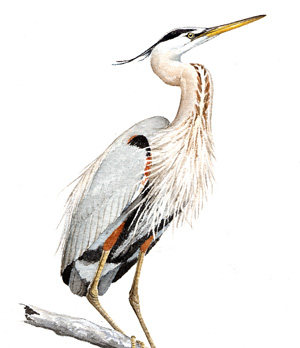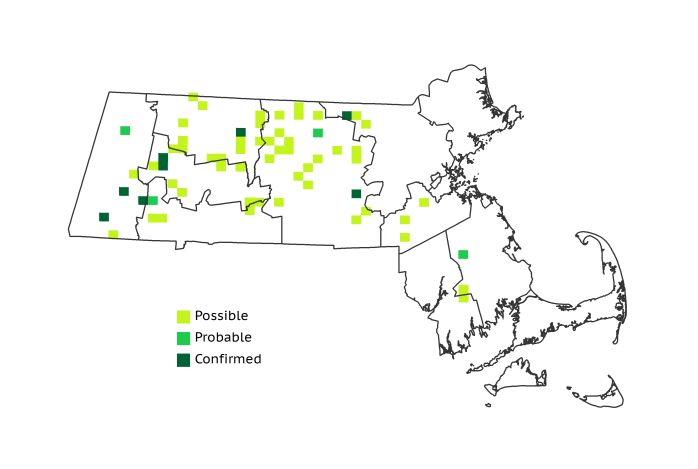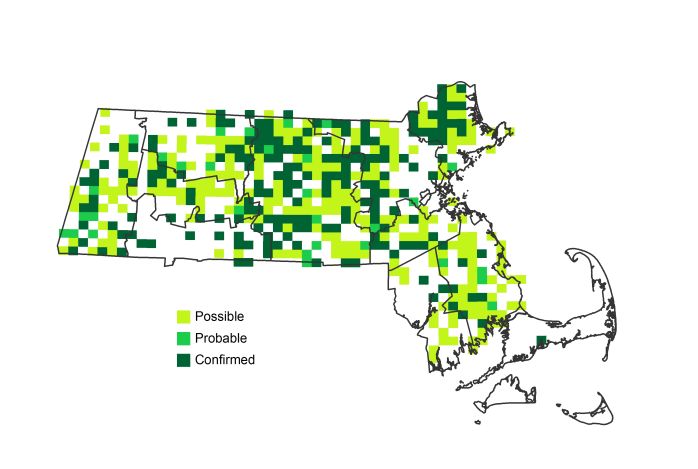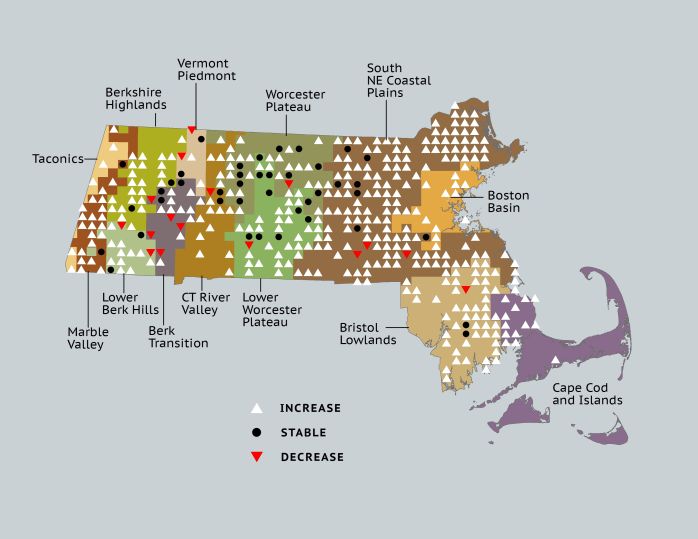Breeding Bird Atlases (BBA)
Find a Bird
Great Blue Heron
Ardea herodias

Fairly widespread and strongly increasing
“The heron stands in water where the swamp/ Has deepened to the blackness of a pool, / Or balances with one leg on a hump / Or marsh grass heaped above a muskrat hole.” – Theodore Roethke, “The Heron”
Perhaps no wading bird in Massachusetts is more familiar than the graceful and statuesque Great Blue Heron. This species has very adaptable feeding habits, readily taking fish, amphibians, crustaceans, reptiles, and sometimes even small mammals. Its broad menu has made it a common sight at ponds, rivers, lakes, streams, marshes, estuaries, coastal bays, and meadows across the state in recent years. That hasn’t always been the case, however. A century ago, breeding Great Blue Herons were all but absent from the Commonwealth of Massachusetts.
Historic Status
Gifted with beautiful plumage, the Great Blue Heron was a “constant resident in Massachusetts” in the 1830s (Peabody 1839), hardy enough to withstand a New England winter and just as well suited for the more temperate days of summer. By the 1870s, the question was raised as to whether or not Great Blue Herons still nested in Massachusetts. Hunted for its beautiful plumes, the species became known as a common migrant but a “not common summer resident” (Allen, 1878). By the 1920s, Edward Howe Forbush described the species as having “bred not many years ago in Massachusetts” (Forbush 1925). The same year that Forbush's first volume of The Birds of Massachusetts and Other New England States was released in 1925, a Great Blue Heron nesting colony was located in the Harvard Forest in Petersham. The colony survived until it was destroyed by the hurricane of 1938, and no colonies of like size were found in Massachusetts for the next 30 years.
Atlas 1 Distribution
Wide-ranging Great Blue Herons were spotted in more than 60 blocks during Atlas 1, mostly in the central and western parts of the state. The highest western areas in the Taconic Mountains and Berkshire Highlands had little or no heron activity, but the Lower Berkshire Hills, Vermont Piedmont, and especially Berkshire Transition regions each held blocks supporting a handful of Great Blue Herons. Interestingly, the waterways coursing through the Connecticut River Valley had only 3 occupied blocks and no Confirmations, while the Worcester Plateau accounted for a quarter of all Atlas 1 records for the species. The Lower Worcester Plateau and Coastal Plains together contributed 22 out of 64 blocks, but the only region east of the Coastal Plains to report breeding Great Blue Herons was the Bristol/Narragansett Lowlands (3 blocks).
Atlas 2 Distribution and Change
With plume hunters no longer a threat, Great Blue Herons have returned to Massachusetts. Aided by the early-twentieth-century reintroduction of the beaver, Great Blues took to the newly created wetlands for which that toothy mammal is so well known with aplomb. The numbers alone reflect this situation: from 7% block occupancy in Atlas 1 to 46% in just 35 years. When looking at the blocks with the best survey data, every ecoregion in the state except the Vermont Piedmont underwent increases in the presence of this species, and the Vermont Piedmont maintained an even pace. To further illustrate the species’ growth, consider these facts: in the Berkshire Highlands, Great Blue Herons were found in 22 blocks where they were not detected in Atlas 1. In the Bristol/Narragansett Lowlands, they were found in 46 new blocks, and on the Coastal Plains, they were located in 140 new blocks. Great Blue Herons are back!
Atlas 1 Map

Atlas 2 Map

Atlas Change Map

Ecoregion Data
Atlas 1 | Atlas 2 | Change | ||||||
Ecoregion | # Blocks | % Blocks | % of Range | # Blocks | % Blocks | % of Range | Change in # Blocks | Change in % Blocks |
Taconic Mountains | 0 | 0.0 | 0.0 | 5 | 20.0 | 1.0 | 5 | 33.3 |
Marble Valleys/Housatonic Valley | 2 | 5.1 | 3.1 | 23 | 59.0 | 4.8 | 21 | 53.8 |
Berkshire Highlands | 2 | 3.6 | 3.1 | 25 | 45.5 | 5.2 | 22 | 41.5 |
Lower Berkshire Hills | 4 | 14.3 | 6.3 | 14 | 45.2 | 2.9 | 10 | 37.0 |
Vermont Piedmont | 4 | 23.5 | 6.3 | 5 | 29.4 | 1.0 | 0 | 0.0 |
Berkshire Transition | 8 | 21.1 | 12.5 | 17 | 42.5 | 3.5 | 6 | 19.4 |
Connecticut River Valley | 3 | 5.4 | 4.7 | 21 | 32.3 | 4.4 | 13 | 27.1 |
Worcester Plateau | 16 | 20.5 | 25.0 | 62 | 70.5 | 12.9 | 26 | 54.2 |
Lower Worcester Plateau | 10 | 13.5 | 15.6 | 55 | 68.8 | 11.5 | 30 | 55.6 |
S. New England Coastal Plains and Hills | 12 | 4.4 | 18.8 | 176 | 62.2 | 36.7 | 137 | 60.6 |
Boston Basin | 0 | 0.0 | 0.0 | 13 | 23.2 | 2.7 | 13 | 23.6 |
Bristol and Narragansett Lowlands | 3 | 2.8 | 4.7 | 48 | 42.1 | 10.0 | 45 | 44.6 |
Cape Cod and Islands | 0 | 0.0 | 0.0 | 16 | 11.1 | 3.3 | 15 | 12.5 |
Statewide Total | 64 | 6.6 | 100.0 | 480 | 46.3 | 100.0 | 343 | 41.4 |
Notes
For wide-ranging foragers like Great Blue Herons, the Possible and Probable locations can give a false impression of this species’ footprint. Great Blue Herons nest in colonies, and their large stick nests atop dead trees or buildings tend to be rather conspicuous. Herons can – and do – range several miles afield from their nests for food or nesting material, so a heron seen in proper habitat within Safe Dates might actually be a breeder 2 or 3 blocks over. Thus, the best way to understand the trend of this species is to evaluate Confirmed blocks. Great Blue Herons show significant increasing Breeding Bird Survey trends in Massachusetts, the New England/mid-Atlantic region, and the eastern US region.



